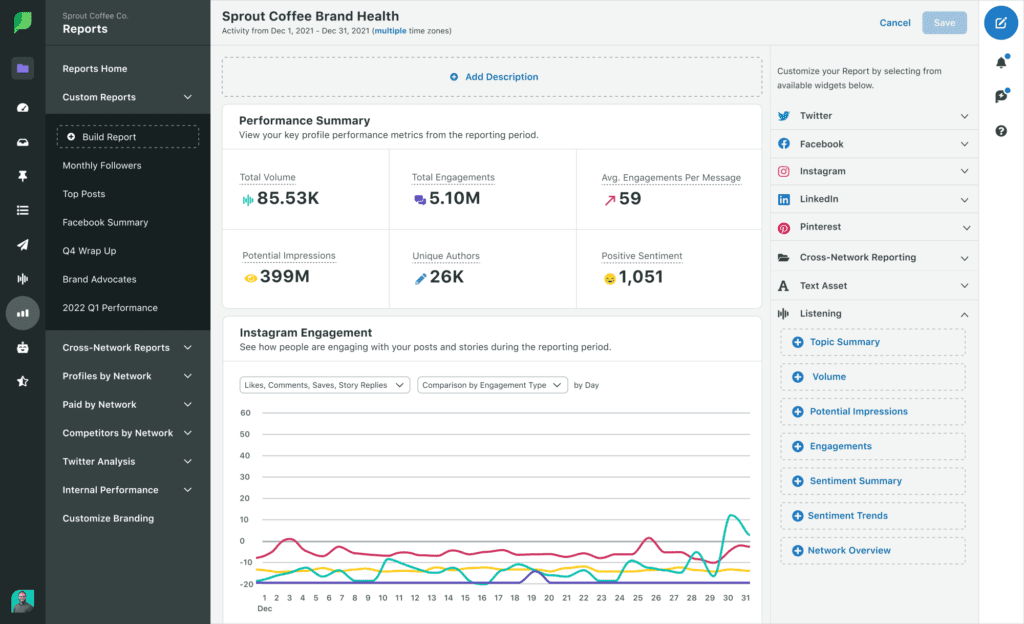Whether you’ve been in the game for years or just starting out as a social media manager, setting SMART goals for social media isn’t just a skill—it’s an essential part of any social media strategy.
These goals serve as a compass, aligning every post, campaign, and interaction with broader objectives. They’re vital in navigating the fast-moving world of social media, enabling social media managers to track progress, adjust tactics based on real data, and demonstrate the tangible value and impact of their work to stakeholders.
In this guide, we’ll show you how social media SMART goals work, why they matter, and tips for setting and reporting on your own goals.
Unpacking the SMART framework
Each element of SMART – Specific, Measurable, Achievable, Results-focused, and Time-bound – plays a vital role in crafting goals that are not only clear and attainable but also impactful for your business.
Let’s break them down:
Specific
Specificity is about laser-focusing your goals.
For example, rather than vaguely aiming to “increase brand presence,” a specific goal is quantifiable, like “Boost Instagram followers by 20% within three months.”
This precision clarifies your target, making strategy development more straightforward.
Measurable
The measurable aspect is about tracking and quantifying success.
It’s crucial to have concrete criteria for measuring progress towards achieving your goals.
If your goal is to increase engagement, you need a system to track metrics like likes, shares, comments, or click-through rates.
Achievable
Setting achievable goals means assessing your resources, understanding market trends, and recognizing your brand’s current standing.
It’s about balancing ambition with realism. If your Instagram account is growing steadily, aiming for a three-fold increase in followers overnight might not be feasible.
An achievable goal is challenging yet realistic, keeping your team motivated and focused.
Results-focused
This part is about ensuring your goals directly impact your business’s success.
If the objective is to boost website traffic from social media platforms by 30%, you’re setting a goal with a clear outcome that positively influences your overall business performance.
Time-bound
Imposing deadlines is critical for maintaining momentum and urgency.
A time-bound goal has a clear endpoint, offering a timeframe for achieving your objectives. This helps in planning, executing, and adjusting strategies effectively.
If your goal is to improve web traffic, setting a three-month deadline allows you to evaluate progress and recalibrate as needed.
Creating social media SMART goals: A practical exercise
Let’s turn theory into action with a hands-on exercise in creating social media SMART goals tailored for various platforms. Whether you’re managing a boutique, a tech startup, or a local cafe, these examples will guide you in setting specific, measurable, achievable, results-focused, and time-bound goals to elevate your social media strategy.
Let’s say you’re working for a fashion retailer and want to focus on Instagram.
Your goal could be: “Boost the average likes per post by 25% over the next four months by collaborating with three local influencers and using targeted hashtags.”
Now let’s break that down:
- Specific: “Boost the average likes per post by 25%.” This goal precisely outlines what needs to be achieved – an increase in likes per post.
- Measurable: The goal is quantifiable – “25% increase.” This allows for tracking progress through Instagram analytics.
- Achievable: Collaborating with local influencers and using targeted hashtags are realistic and effective methods to increase engagement, making the goal attainable.
- Results-focused: The goal is oriented towards a tangible outcome that positively impacts social media presence and engagement.
- Time-bound: The timeframe of “over the next four months” provides a clear deadline, adding a sense of urgency and helping in planning and evaluating the strategy’s effectiveness.
Here are some more goal examples. See if you can identify each SMART component:
- Bookstore on Twitter: “Increase Twitter followers by 30% in six months by hosting bi-weekly author Q&A sessions and promoting exclusive book releases.”
- Health Food Brand on LinkedIn: “Achieve a 20% rise in LinkedIn post shares within three months by sharing weekly informative articles on nutrition and wellness trends.”
- Tech Startup on YouTube: “Grow YouTube channel subscriptions by 40% in five months by releasing bi-weekly tech tutorials and industry analysis videos.”
- Travel Agency on Pinterest: “Increase Pinterest referral traffic to the website by 35% in the next quarter by curating and pinning high-quality travel imagery and destination guides.
Deciding on SMART goals for social media
When selecting SMART goals for social media, collaboration with your social media manager, social media lead or other marketing stakeholders is key. Here’s a guide to navigate this process:
- Understand business objectives: Align with your manager to understand the broader business objectives. Your social media goals should directly contribute to these.
- Assess current performance: Analyze current social media performance to identify areas of opportunity or improvement.
- Brainstorm with stakeholders: Hold a brainstorming session with stakeholders. Discuss potential goals and get feedback on what’s most important from their perspective.
- Evaluate resources: Consider the resources available to you – budget, manpower, tools. This will help in setting achievable goals.
- Set priorities: From the brainstorming session, prioritize goals that align most closely with business objectives and resource availability.
- Formulate SMART goals: Transform these priorities into SMART goals for social media. Ensure they are specific, measurable, achievable, results-focused, and time-bound.
- Review and approve goals: Present these goals to your social media director, manager or relevant stakeholders for approval, ensuring they are in agreement with the proposed direction.
- Regularly review progress: Set regular check-ins to review progress against these social media SMART goals, making adjustments as necessary based on feedback from stakeholders and performance data.
This collaborative approach ensures your social media goals are not only SMART but also aligned with the overall strategic vision of your organization.
Tracking your SMART goals
To effectively track and report on your SMART goals for social media, make sure you use the right social media management tools with robust analytics features. For instance:
- Hootsuite: Offers comprehensive tracking of posts’ performance, engagement rates, and audience growth, allowing for detailed analysis aligned with your specific goals.
- Sprout Social: Known for its deep analytics and reporting features, Sprout Social helps in understanding audience engagement and content performance.
- Buffer: Provides insights into post reach and engagement, helping you measure the effectiveness of your content strategy.
These tools not only offer valuable data on audience behavior and engagement patterns but also enable you to generate reports that can be shared with stakeholders to demonstrate the progress and impact of your social media strategies.

Things to remember when setting social media SMART Goals
In setting SMART goals for social media, it’s common to either set too many goals or create goals that are too broad and unfocused. To tackle this, prioritize one or two key areas that align closely with your business objectives.
This focused approach ensures more manageable and effective goal management. Plus, it’s crucial to maintain flexibility.
Regularly reviewing and adjusting your goals based on analytics and performance data allows you to stay responsive to changes in social media trends and audience engagement.
This adaptability ensures your goals remain relevant and achievable, keeping your strategy on the path to success.
Benefits for your career
Incorporating SMART goals into your social media strategy is more than just a technique; it’s a career-building skill, especially if you’re aiming for more senior roles, like Social Media Strategist jobs or Social Media Director jobs.
By focusing on specific, measurable, achievable, results-focused, and time-bound goals, you’re not only setting a path for success but also demonstrating strategic thinking and results-oriented planning.
These skills are invaluable in the social media field and can significantly enhance your professional growth and opportunities in more advanced roles.




